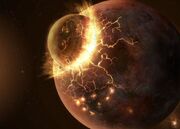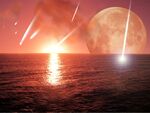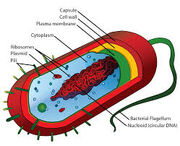| This project is no longer active. |
| It is no longer being continued by the author, nor has anyone else started working on it. It has been kept as an archive because of quality content. If you want to adopt it to work on it, please contact the author on their message wall. |
"It's like the garden of Eden with teeth and claws"
| Adjective | Thalassan | ||||||||
|---|---|---|---|---|---|---|---|---|---|
| Orbital characteristics | |||||||||
| Aphelion | 147098290 km (0.98329134 AU) | ||||||||
| Perihelion | 107477000 km (0.718440 AU) | ||||||||
| Orbital period | 14 days (whilst orbiting Theia) | ||||||||
| Average orbital speed | 29.78 km/s | ||||||||
| Satellite of | Theia | ||||||||
| Satellites | 1 (Pontus) | ||||||||
| Physical characteristics | |||||||||
| Mass | 0.72 Earths | ||||||||
| Mean density | 0.88 Earths | ||||||||
| Rotation period | 20 hours | ||||||||
| Axial tilt | 0° | ||||||||
| |||||||||
| Atmosphere | |||||||||
| Composition | Nitrogen (60.3%) Oxygen (28.7%) Carbon dioxide (6.5%) Argon (1.5%) Other noble gasses (1.9%) Trace gasses (2.1%) | ||||||||
Thalassa is the seventh satellite from Theia, the densest, and the eighth largest planetary object. It has conditions similar to Earth's; however an abundance of carbon monoxide has stunted the development of human settlements.
Its physical properties allowed organisms to proliferate; around fifty-millions years after its formation, a protoplanet smashed into Thalassa, bringing large quantities of cobalt which forms the basis of the chemical coboglobin, which is the dominant oxygen-transporter. The excess material left from this event formed its only satellite Pontus, which brighten ups the night sky (due to its albedo). Life on Thalassa has proliferated and both products produced by the biosphere (such as oxygen) and positive feedback had contributed to life and its prolonged existence.
Chronology
Formation
Polyphemus first started as a large collapsing cloud of gas inside an ancient interstellar cloud. A solar nebula partitions a volume out of a molecular cloud by gravitational collapse, which begins to spin and flatten into a circumstellar disk, the central bulge continued to collapse under its own gravity until deep in its interior the temperatures got so high (several million degrees) that deuterium atoms began to fuse and give off thermonuclear energy. This slowed the collapse down a bit and eventually led to a second stage where hydrogen nuclei could fuse into helium, which then started the sun's current evolutionary phase. The material of this accretion disk consists of heavier elements as the solar wind (which was stronger at the time) repelled lighter elements away from the accretion disk.

A large proto-planet slams into Thalassa; forever changing its fate.
Thalassa was formed by accretion, from the excess material colliding with each other, forming into planetesimals which also collide with each other. Most of these planetesimals eventually break apart during violent collisions, however some survive these encounters and grow into protoplanets, and later planets and moons. Thalassas’ first atmosphere consists of mostly hydrogen and helium, later stripped away by intense blasts of solar wind. It was a rogue planet, for the first fifty million years of its existence; however it collided with a rogue protoplanet dubbed Thalia, the collision was so violent that it vaporised large amounts of silicate. This impact caused a “gravitational slingshot” event; pulling Thalassa towards the outer rims of the Polyphemian system. It was captured by the immense gravitational pull of Theia, a water cloud jovian that consists mostly of hydrogen rich molecules such as methane and water vapour.

Early Thalassa with its oceans starting to form
Over the next billion years; its surface began to cool. The liquid motion of internal materials (such as molten iron and electromagnetically conductive magma) continuously rotating and churning up produced a dynamo, turning mechanical energy to electromagnetic energy, which formed the magnetosphere. Its first atmosphere consists of mostly hydrogen and helium, only to be stripped away by intense blasts of solar winds. Outgassing from volcanoes produced a second atmosphere; which consists of more volatile gasses such as water vapor, nitrogen, oxygen, and carbon dioxide. A billion years after its formation, the moon began to experience plate tectonics, a system in which on a geological time-scale. The ocean crust, which has by this time cooled and solidified, continues to move across the planet's surface driven by internal factors, such as the mantle's continuous loss of heat.
The earliest physical evidence of life in Thalassa is biogenic graphite, dating from four and a half billion years ago. The first organisms appeared via abiogenesis, the process by which life originated from certain chemicals such as carbon, hydrogen, nitrogen, oxygen, phosphorous, and sulphur. The first bacterium that utilizes photosynthesis appeared four billion years ago, turning carbon dioxide, energy emitted from the sun, and water to produce glucose, a type of sugar. Around two billion years ago, a drastic reduction of greenhouse gasses began the Cyroecrixian glaciation (which is similar to the cyrogenian glaciation but more severe). When the ultraviolet rays interact with the ice, an oxygen-rich chemical called hydrogen peroxide is produced. Since Thalassa was covered by ice, carbon dioxide could not be withdrawn from the atmosphere by release of alkaline metal ions weathering out of siliceous rocks. However a sharp increase in gasses such as carbon dioxide and methane emitted from volcanoes would accumulate to finally cause enough greenhouse effect to allow the equator to develop a band of ice-free water and land, which thus absorbs the suns' energy more effectively than the ice -- initiating "positive feedback". Melting hydrogen peroxide released a significant amount of oxygen gas, together with the sediments which are rich with nutrients such as phosphorous and high oxygen concentration, allowed large multicellular organisms to develop and proliferate. Prior to the colonisation of land, an oxygen allotrope called ozone began to fill the atmosphere, blocking most of the harsh ultraviolet radiation.

The first unicelluar organisms looked similar to this; however its structure is slightly different.
Biology
Lifeforms inside the moon are very similar to those of earths’; they are carbon based and use similar amino acids and proteins for genetic coding, and also uses DNA for storing genetic information. Most fauna also utilizes coboglobin as the main oxygen transporter.
Mutatiozoa, which contains fauna, however are slightly different, although they also have need to ingest other organisms or their products to produce energy (Heterotrophs), they contain a more complex nervous system. The extended portions of the nervous system form "neural whips", structures sheathed inside ear like extremities, these neural whips can let different species communicate with others with signals emitted from brains. They also have several dense areas of nerves, which act like a miniature brain, allowing the ability to perform different acts at once. All fauna go through some kind of sexual reproduction. They have few specialised reproductive cells; such as the motile spermatozoa and the non-motile ova. When these cells merge, they form zygotes which continue to develop into individuals. A zygote eventually develops into a blastula. Then, it forms a gastrula with a digestive chamber, and two separate germ layers, an external ectoderm and an internal endoderm. In most cases, a mesoderm also develops between them. These germ layers then differentiate to form tissues and organs. Almost all fauna possesses true eyes, however some instead have small patches of photoreceptor proteins, which can only sense ambient brightness.
Thalassan plants are photosynthetic, which means they manufacture their own food molecules obtained from energy from light, the primary mechanism used to capture light is the pigment chlorophyll, which explains the colour. Photosynthesis is the process which turns light, carbon dioxide, and water into glucose, a form of sugar. Thalassan plants also evolved primitive organs and tissues, and even a primitive (yet vestigial) nervous system. There are two plant regnums, Virenfoliae and Zooplantae. The indigenious trees are notably similar to those of our planets other than their larger proportions and their structure due to the lighter gravity. At night virtually all plants glow due to bioluminescence in various shades of blue, purple and occasionally red. All plants can communicate with electromagnetic signals that effectively act as neurons.
Composition
Atmospheric Composition
Thalassa's is considerably thicker and more compact than earth's. The atmosphere consists of; nitrogen (60.3%), oxygen (28.7%), carbon dioxide (6.5%), argon (1.5%), noble gasses (1.9%) and trace other gasses (2.1%). The total amount of water vapour varies between seasons due to the ever changing climate (due to Theias' exaggerated elliptical orbit). The lethal levels of carbon dioxide render humans unconscious in forty seconds, and dead in eight minutes. The thicker atmosphere causes airborne animals to fly with relative ease.. Plants are a subject to greater wind force, as the greater air density means that the moving air carries more kinetic energy, and flora must have greater strength or flexibility to resist it. The increased mass of the denser air means that it requires more force for an object to accelerate whilst moving through Thalassa's atmosphere -- Smaller fauna experience this when they try to run, it feels like there is a wind blowing against them, even though the air is still.
Chemical Composition
The composition of Thalassa is as follows; iron (33.5%), oxygen (30.2%) silicon (16.7%), magnesium (14.1%), nickel (2.0%), cobalt (1.0%) and sulphur (0.7%) with the remaining 1.8% being taken up with trace amounts of other elements. The core however, is mostly comprised of molten iron (91.7%). This large amount of iron in the core is the result of mass segregation, where heavier elements, move towards the centre of gravity. The rising motion of lighter elements form the foundations of the magnetosphere.
